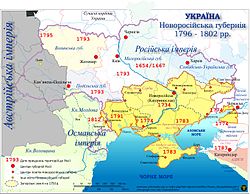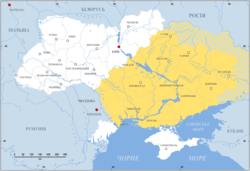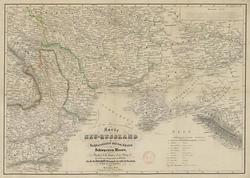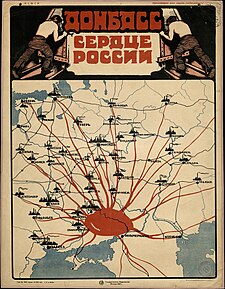Novorossiya
This article needs additional citations for verification. (June 2023) |

Novorossiya
Novorossiya Governorate was formed (1764) from
History
Wild Fields


The modern history of the region follows the fall of the Golden Horde. The eastern portion was claimed by the Crimean Khanate (one of its multiple successors), while its western regions were divided between Moldavia and Lithuania. With the expansion of the Ottoman Empire, the whole Black Sea northern littoral region came under the control of the Crimean Khanate that in turn became a vassal of the Ottomans.[citation needed] Sometime in the 16th century the Crimean Khanate allowed the Nogai Horde which were displaced from its native Volga region by Muscovites and Kalmyks to settle in the Black Sea steppes.[citation needed]
Vast regions to the North of the Black Sea were sparsely populated and were known as the
Russian expansion
The Russian Empire gradually gained control over the area, signing peace treaties with the
The old steppe was Asian and stateless; the current one was state-determined and claimed for European-Russian civilization. The world of comparison was now even more obviously that of the Western empires. Consequently it was all the more clear that the Russian empire merited its own New Russia to go along with everyone else's New Spain, New France, and New England. The adoption of the name of New Russia was in fact the most powerful statement imaginable of Russia's national coming of age.[5]
The administrative centre of the Novorossiysk Governorate was at the St. Elizabeth fortress (today in Kropyvnytskyi) in order to protect the southern borderlands from the Ottoman Empire, and in 1765 this passed to Kremenchuk.[4][6]
After the annexation of the Ottoman territories to Novorossiya in 1774, the Russian authorities commenced a broad program of colonization, encouraging large migrations from a broader spectrum of ethnic groups. Catherine the Great invited European settlers to these newly conquered lands:
The population consisted of military colonists from hussar and lancer regiments, Ukrainian and Russian peasants, Cossacks, Serbs, Montenegrins, Hungarians, and other foreigners who received land subsidies for settling in the area.[7]
In 1775, the Russian Empress

From 1822 to 1874 the Novorossiysk-Bessarabia General Government was centred in
Legacy
This section needs expansion. You can help by adding to it. (April 2014) |
Following the
The name received renewed emphasis when
Demographics
Ethnicity
The ethnic composition of Novorossiya changed during the beginning of the 19th century due to the intensive movement of colonists who rapidly created towns, villages, and agricultural colonies. During the
Multiple ethnicities[clarification needed] participated in the founding of the cities of Novorossiya (most of these cities were expansions of older settlements[21]). For example:
- Zaporizhzhia as formerly the site of a Cossack fort
- Richelieu(in office 1803–1814)
- Donetsk, founded in 1869, was originally named Yuzovka (Yuzivka) in honor of John Hughes, the Welsh industrialist who developed the coal region of the Donbas
According to the report of governor Shmidt, the ethnic composition of Kherson Governorate (which included the city of Odesa) in 1851 was as follows:[22]
| Nationality | Number | % |
|---|---|---|
| Ukrainians | 703,699 | 69.14 |
| Romanians (Moldavians and Vlachs) | 75,000 | 7.37 |
| Jews | 55,000 | 5.40 |
| Russian-Germans | 40,000 | 3.93 |
Great Russians |
30,000 | 2.95 |
| Bulgarians | 18,435 | 1.81 |
| Belarusians | 9,000 | 0.88 |
| Greeks | 3,500 | 0.34 |
| Romani people | 2,516 | 0.25 |
| Poles | 2,000 | 0.20 |
| Armenians | 1,990 | 0.20 |
| Karaites | 446 | 0.04 |
| Serbs | 436 | 0.04 |
| Swedes | 318 | 0.03 |
| Tatars | 76 | 0.01 |
| Former Officials | 48,378 | 4.75 |
| Nobles | 16,603 | 1.63 |
| Foreigners | 10,392 | 1.02 |
| Total Population | 1,017,789 | 100 |
Language
With regard to language usage, Russian was commonly spoken in the cities and some outside areas, while Ukrainian generally predominated in rural areas, smaller towns, and villages.[clarification needed]
The 1897

| Language | Kherson Guberniya | Yekaterinoslav Guberniya | Tavrida Guberniya |
|---|---|---|---|
| Ukrainian | 53.4% | 68.9% | 42.2% |
| Russian | 21.0% | 17.3% | 27.9% |
| Belarusian | 0.8% | 0.6% | 6.7% |
| Polish | 2.1% | 0.6% | 0.6% |
| Bulgarian | 0.9% | – | 2.8% |
| Romanian | 5.3% | 0.4% | 0.2% |
| German | 4.5% | 3.8% | 5.4% |
| Jewish (sic) | 11.8% | 4.6% | 3.8% |
| Greek | 2.3% | 2.3% | 1.2% |
| Tatar | 8.2% | 8.2% | 13.5% |
| Turkish | 2.6% | 2.6% | 1.5% |
| Total Population | 2,733,612 | 2,311,674 | 1,447,790 |
The 1897
| Language | Odesa | Yekaterinoslav | Mykolaiv | Kherson | Sevastopol | Mariupol | Donetsk district |
|---|---|---|---|---|---|---|---|
| Russian | 198,233 | 47,140 | 61,023 | 27,902 | 34,014 | 19,670 | 273,302 |
| Jewish (sic) | 124,511 | 39,979 | 17,949 | 17,162 | 3,679 | 4,710 | 7 |
| Ukrainian | 37,925 | 17,787 | 7,780 | 11,591 | 7,322 | 3,125 | 177,376 |
| Polish | 17,395 | 3,418 | 2,612 | 1,021 | 2,753 | 218 | 82 |
| German | 10,248 | 1,438 | 813 | 426 | 907 | 248 | 2,336 |
| Greek | 5,086 | 161 | 214 | 51 | 1,553 | 1,590 | 88 |
| Total Population | 403,815 | 112,839 | 92,012 | 59,076 | 53,595 | 31,116 | 455,819 |
List of founded cities
Many of the cities that were founded (most of these cities were expansions of older settlements[21]) during the imperial period are major cities today.
Imperial Russian regiments were used to build these cities, at the expense of hundreds of soldiers’ lives.[21]
First wave
- Yelisavetgrad (Kropyvnytskyi) (1754)
- Aleksandrovsk (Zaporizhzhia) (1770)
- Yekaterinoslav (Dnipro) (1776)
- Kherson (1778)
- Mariupol (1778)
- Sevastopol (1783)
- Simferopol (1784)
- Melitopol (1784)
- Pavlohrad (1784)
Second wave
Third wave
- Berdyansk(1827)
- Novorossiysk (1838)
See also
- Battle of Kherson 2022
- White Russia
- Donetsk–Krivoy Rog Soviet Republic
- Great Russia
- Little Russia
- New Serbia
- Novorossiya (confederation)
- Old Great Bulgaria
- Russian irredentism
- Russian occupation of Kherson Oblast 2022
- Slavo-Serbia
- Southern Ukraine
- Territorial evolution of Russia
Notes
- ^ Russian: Новороссия, tr. Novorossiya, IPA: [nəvɐˈrosːʲɪjə] ⓘ; Ukrainian: Новоросія, romanized: Novorosiia; Romanian: Noua Rusie, Polish: Noworosja
- ^ Kharkiv was the centre of the historical region of Sloboda Ukraine.[15] A portion of modern Kharkiv Oblast includes territory of the late-eighteenth century Novorossiya Governorate.[16]
References
- ^ Mikhail Levchenko (1874). Opyt russko-ukrainskago slovari︠a︡. Kyiv: Tip. Gubernskago upravlenii︠a︡, p 188.
- ^ "Plan for the Colonization of New Russia Gubernia" issued by the Russian Senate - New Russia Gubernia at the Encyclopedia of Ukraine
- ^ Magocsi, Paul R. "A History of Ukraine: The Land and Its Peoples," p. 284.
- ^ a b Nataliya Polonska-Vasylenko (1955). The Settlement of the Southern Ukraine (1750-1775). Ukrainian Academy of Arts and Sciences in the U.S. p. 190.
- ISBN 0-8014-7347-0.
- ^ "New Russian gubernia". Encyclopedia of Ukraine. Archived from the original on 15 August 2015. Retrieved 4 January 2015.
- ISBN 978-0-8108-7847-1.
- ^ E. Lozovan, Romanii orientali, "Neamul Romanesc", 1/1991, p.14
- ^ E. Lozovan, Romanii orientali, "Neamul Romanesc", 1/1991, p.32.
- ^ "The CIS Handbook", edited by Patrick Heenan, Monique Lamontagne, Fitzroy Dearborn Publishers, 1999, p. 75.
- ^ "Federal State of Novorossiya". GlobalSecurity.org. Archived from the original on 9 August 2014. Retrieved 18 February 2015.
A Russian ethnic republic in Ukraine was named Novorossiya and was proclaimed in 1992 but fell some days after.
- ^ a b Paul Kolstoe. "Russians in the Former Soviet Republics", Indiana University Press, June 1995, p. 176.
- ISBN 978-1-56324-637-1.
- ^ "Transcript: Vladimir Putin's April 17 Q&A". Washington Post. Archived from the original on 8 February 2015. Retrieved 18 February 2015.
- ISBN 0802039375(page 19)
- ISBN 1784530646(page 9)
- ^ СМИ: Террористы из "ДНР" и "ЛНР" объединились [Mass media: Terrorists of the "LNR" and "DNR" have united] (in Russian). UNIAN. 24 May 2014. Archived from the original on 25 May 2014. Retrieved 26 May 2014.
- Gazeta.ru (in Russian). Archivedfrom the original on 19 December 2016. Retrieved 17 June 2016.
- ^ "Why the Kremlin Is Shutting Down the Novorossiya Project". Carnegie Endowment for International Peace. Archived from the original on 22 December 2015. Retrieved 20 December 2015.
- ^ "'Internal betrayal': Transcript of Vladimir Putin's address". Al Jazeera.
- ^ a b c d Odesa: Through Cossacks, Khans and Russian Emperors Archived 24 October 2018 at the Wayback Machine, The Ukrainian Week (18 November 2014)
- ^ Шмидт А. "Материалы для географии и статистики, собранные офицерами генерального штаба. Херсонская губерния. Часть 1". (tr. "Schmidt A.: Materials for geography and statistics collected by officers of the general staff. Kherson province. Part 1") St. Petersburg, 1863, p. 465-466
- ISSN 1726-2887. Archived from the original on 2 May 2014. Retrieved 4 January 2015.)
{{cite journal}}:|issue=has extra text (help - ISSN 1726-2887. Archived from the original on 4 March 2016. Retrieved 4 January 2015.)
{{cite journal}}:|issue=has extra text (help - ISSN 1726-2887. Archived from the original on 17 May 2014. Retrieved 4 January 2015.)
{{cite journal}}:|issue=has extra text (help - ISSN 1726-2887. Archived from the original on 11 September 2014. Retrieved 4 January 2015.)
{{cite journal}}:|issue=has extra text (help
External links
 Media related to Novorossiya at Wikimedia Commons
Media related to Novorossiya at Wikimedia Commons- Map of Novorossiya (New Russia)
- Novorossiya leaders and Odesa mayors Archived 3 March 2016 at the Wayback Machine
